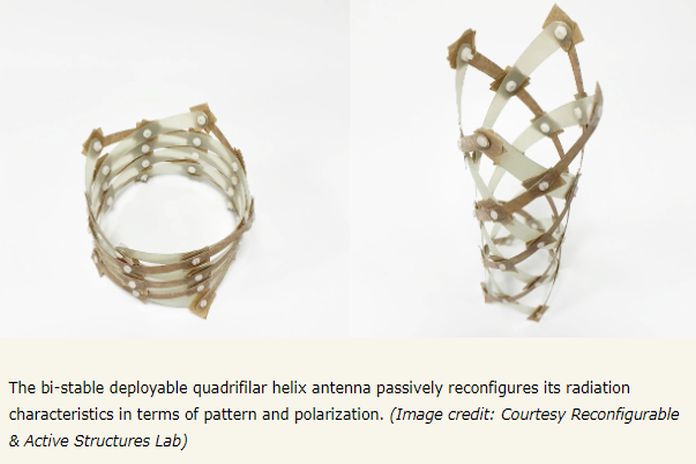By Laura Castañón
CALIFORNIA, USA, (Stanford News) – When an earthquake, flood, or other disaster strikes a region, existing communication infrastructure such as cell phone and radio towers are often damaged or destroyed. Restoring emergency communications as quickly as possible is vital for coordinating rescue and relief efforts.
Researchers at Stanford University and the American University of Beirut (AUB) have developed a portable antenna that could be quickly deployed in disaster-prone areas or used to set up communications in underdeveloped regions. The antenna, described recently in Nature Communications, packs down to a small size and can easily shift between two configurations to communicate either with satellites or devices on the ground without using additional power.
“The state-of-the-art solutions typically employed in these areas are heavy, metallic dishes. They’re not easy to move around, they require a lot of power to operate, and they’re not particularly cost-effective,” said Maria Sakovsky, an assistant professor of aeronautics and astronautics at Stanford. “Our antenna is lightweight, low-power, and can switch between two operating states. It’s able to do more with as little as possible in these areas where communications are lacking.”
Two functions in one antenna
The researchers developed the antenna with an approach typically used to design devices that are being deployed in space. Because of fuel and space limitations, technology being sent into orbit must be very lightweight and packaged as small as possible. Once the items are in orbit, they unfold into the proper shape for use. The researchers wanted their antenna to be similarly collapsible and lightweight.
The antenna designed by Sakovsky and her colleagues at AUB, including Joseph Costantine, Youssef Tawk, and Rosette Maria Bichara, is made of fiber composites (a material often used in satellites) and resembles a child’s finger-trap toy, with multiple strips of material crossing in spirals. Just like any helix-based antenna, conductive material running through the antenna sends out signals, but thanks to its unique structure, the researchers can adjust the pattern and power of those signals in the new antenna by pulling it into longer shapes or shorter shapes.
“Because we wanted the antenna to be able to collapse into a packable shape, we started with this structure that led us to a very untraditional antenna design,” Sakovsky said. “We’re using shapes that have never been used on helical antennas before, and we’ve shown that they work.”
At its most compact, the antenna is a hollow ring that stands just over one inch tall and about five inches across – not much larger than a bracelet – and weighs 1.4 ounces. In this shape, it’s able to reach satellites with a high-power signal sent in a particular direction. When stretched out to about a foot tall, the antenna sends a lower power signal in all directions, more like a Wi-Fi router.
Shifting between these two states is as simple as pulling or pushing on the antenna. These movements don’t even need to be particularly precise because, once the antenna is moved past a certain point, the structure snaps to the right position. The specific size and shape of the antenna design will determine which frequencies those two states communicate across.
“The frequency you want to operate at will dictate how large the antenna needs to be, but we’ve been able to show that no matter what frequency you operate at, you can scale this design principle to achieve the same performance,” Sakovsky said.
The fabricated prototype was tested for deployment and structural performance at Stanford and its electromagnetic radiation characteristics at the antenna measurement facilities at AUB.
Applications in orbit
To be deployed in the field, the antenna would need to be paired with a transceiver to send and receive signals, a ground plane to reflect radio waves, and other electronics, but the whole package would still only weigh about two pounds, Sakovsky said. And the antenna’s unique dual functionality means that it could replace multiple heavier antennas in areas where deployment is a challenge.
That includes uses in disaster-struck and underdeveloped areas, but also, potentially, in space. Sakovsky and her colleagues are considering adapting their design for satellite communications, allowing satellites to use the same antenna to talk to each other and to talk to the ground.
“We don’t have a lot of spare operating power, volume, or mass on our spacecraft either,” Sakovsky said. “This holds a lot of potential for replacing multiple antennas on a satellite with a single one.”
Sakovsky is affiliated with the Stanford SystemX Alliance. Other co-authors are from American University of Beirut.
This work was funded the Swiss State Secretariat for Education, Research, and Innovation.





